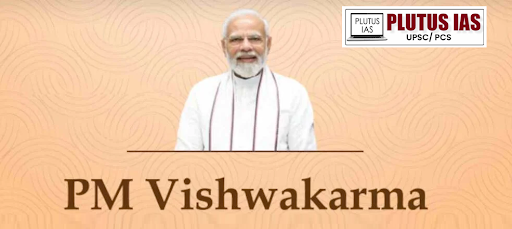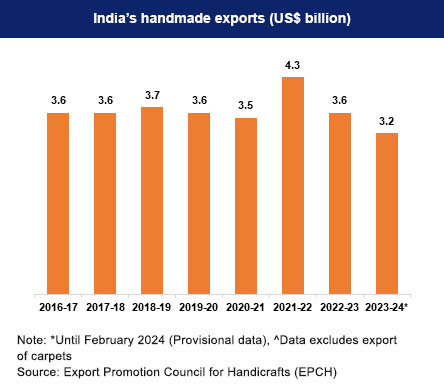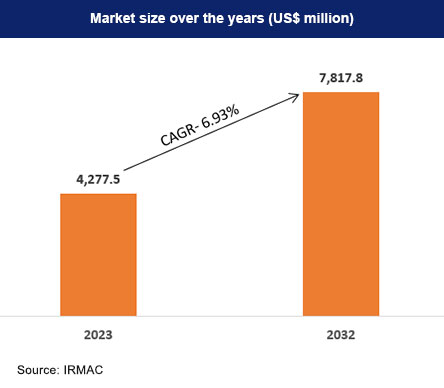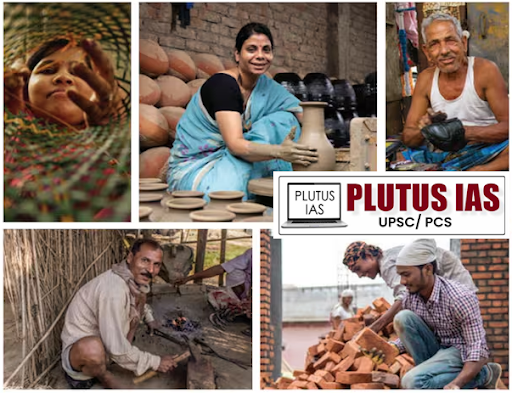21 Sep Strengthening Heritage: Social Security through the PM Vishavarma Scheme
This article covers “Daily Current Affairs” and topic details of the PM Vishavarma scheme for giving social security to traditional artisans.
Syllabus mapping:
GS-1: Social Issues: The impacts of globalization on the various sectors of Indian society including traditional Artisans and traders.
For Prelims:
What are the PM Vishvakarma scheme objectives, eligibility, etc?
For Mains:
What are the main objectives of the PM Vishwakarma scheme challenges faced by the traditional artisans, and how does this scheme help to overcome these challenges and way forward?
Why in the News?
Prime Minister Shri Narendra Modi addresses the National PM Vishwakarma Program in Wardha, Maharashtra.

India and traditional handicrafts:
The handicrafts sector is a vital part of the Indian economy, employing over seven million individuals. India is known for producing a diverse range of items, including woodware, art metal wares, handprinted textiles, embroidered goods, zari products, imitation jewelry, sculptures, pottery, glassware, attars, and agarbattis.


Global Position: India is one of the largest exporters of handicrafts and a leading player in the homemade carpet segment, both in volume and value.
Clusters: Major clusters include Surat, Bareilly, Varanasi, Agra, Hyderabad, Lucknow, Chennai, and Mumbai. The majority of manufacturing units are located in rural and small-town areas, presenting significant market potential both domestically and internationally. India boasts 744 handicraft clusters that collectively employ nearly 212,000 artisans and offer over 35,000 distinct products.
Market Size and Projections
Current Market Size: The handicrafts market in India reached US$ 4,277.5 million in 2023.
Projected Market Size: It is expected to grow to US$ 7,817.8 million by 2032.
CAGR: The market is projected to achieve a compound annual growth rate (CAGR) of 6.9% during the period from 2023 to 2032, according to forecasts by IMARC Group.
PM Vishwakarma Scheme
PM Vishwakarma Scheme: PM Vishwakarma Scheme Launched on September 17, 2023, the PM Vishwakarma Scheme is a Central Sector initiative aimed at providing comprehensive support to artisans and craftspeople across 18 traditional trades.
Key Facts about the PM Vishwakarma Scheme (2023)
Type: Central Sector Initiative
Objective: Provide comprehensive support to artisans and craftspeople
Focus: Empower individuals engaged in traditional trades
Coverage: Supports artisans across 18 specific trades
Aim: Recognize and enhance the skills of those working with hands and tools
The PM Vishwakarma Scheme offers a range of benefits to artisans and craftspeople:
Recognition: Artisans will receive a PM Vishwakarma certificate and ID card to acknowledge their skills and contributions.
Skill Upgradation: Beneficiaries can undergo Basic Training for 5-7 days and Advanced Training for 15 days or more, with a stipend of ₹500 per day.
Toolkit Incentive: At the start of Basic Skill Training, artisans will receive toolkit incentives of up to ₹15,000 in the form of e-vouchers.
Credit Support: The scheme provides collateral-free ‘Enterprise Development Loans’ of up to ₹3 lakh, disbursed in two phases (₹1 lakh and ₹2 lakh).
Incentive for Digital Transactions: Artisans will earn ₹1 for each digital transaction, up to a maximum of 100 transactions per month, credited to their accounts.
Marketing Support: The scheme provides marketing assistance, including quality certification, branding, onboarding on e-commerce platforms like GeM, and various advertising and publicity efforts to enhance market access and integrate artisans into the value chain.
Significance of the PM Vishwakarma Yojana
Samman (Respect):
Recognition of Traditional Crafts: The scheme elevates the status of traditional artisans, honoring their skills and cultural heritage.
Cultural Pride: Promoting traditional crafts, fosters a sense of pride and appreciation within communities for their craftsmanship.
Focus on Inclusivity: Target beneficiaries primarily from scheduled castes and tribes, promoting economic empowerment among marginalized communities.
Samarthya (Capability):
Skill Development: Initiatives like the Acharya Chanakya Skill Development Center provide free training, enhancing artisans’ skills to meet contemporary demands.
Access to Modern Tools: Distribution of modern machinery and toolkits boosts productivity and efficiency in traditional occupations, empowering artisans to compete in the market.
Empowerment of Artisans: Encourages artisans to transition into entrepreneurship, fostering self-reliance and business acumen.
Samridhi (Prosperity):
Financial Support: The loan scheme facilitates access to capital, enabling artisans to invest in their businesses and expand their operations.

Challenges Faced by Artisans
1. Economic Struggles: Economic instability is a major challenge for artisans. Many face financial difficulties, struggling to make a living due to fluctuating market demands, insufficient compensation for their work, and limited access to profitable markets
2. Technological Shifts: The rise of technology and mechanization presents a significant threat to traditional crafts. Mass-produced, machine-made goods frequently overshadow the uniqueness of handmade items.
3. Limited Market Access: Despite the cultural richness of their crafts, artisans often have limited exposure to broader markets. Remote locations, poor infrastructure, and inadequate marketing options restrict their access to consumers who appreciate their work.
4. Skill Disparity: Traditional craftsmanship in India is often handed down through generations, but modernization and evolving societal trends have prompted many young people to pursue alternative livelihoods. This shift has resulted in a diminishing pool of skilled artisans, threatening the preservation of ancient crafts.
5. Aging Artisans: Many artisans currently practicing these traditional skills are aging, leading to concerns about the continuity of their crafts. As the younger generation moves away from these practices, the risk of losing valuable cultural heritage increases significantly.
6. Lack of Training and Resources: Many artisans lack access to training programs that could help them enhance their skills or learn new techniques. Additionally, limited access to modern tools and materials hinders their ability to innovate and improve the quality of their work.
7. Cultural and Social Pressures: Artisans face social pressures and cultural changes that can weaken their traditional practices. Urbanization and shifting lifestyles can reduce the demand for traditional crafts, making it harder for artisans to sustain their work in a changing society.
Way forwards
Technological Integration: Leveraging technology while maintaining traditional methods can modernize the handicraft sector. This includes using tech for design, marketing, and production to enhance artisans’ market access and visibility globally.
Sustainable Innovations: Focusing on sustainability can transform the handicraft sector. Promoting eco-friendly practices and recycled materials will attract consumers who prioritize ethically produced goods.
Skill Development and Education: Ensuring the survival of traditional crafts depends on transferring skills to younger generations. Implementing skill development programs and integrating artisanal knowledge into educational curricula is vital.
Market Accessibility and Fair Trade: Improving market access for artisans is essential. Initiatives that promote fair trade, develop online platforms, and support cooperatives can ensure fair compensation and broader reach.
Promotion and Awareness: Increasing awareness of the cultural value of artisanal products is crucial. Collaborative efforts among governments, NGOs, educational institutions, and media can significantly enhance craft promotion.
Diversification of Products: Encouraging artisans to diversify their product lines can meet changing consumer preferences, creating new markets and opportunities for growth.
Collaborative Networks: Establishing networks among artisans can facilitate knowledge sharing, resource pooling, and collective bargaining, strengthening their position in the market.
Consumer Education: Educating consumers about the importance of supporting traditional crafts can foster a more dedicated customer base, enhancing demand for artisanal products.
Conclusion:
Preserving India’s traditional handicrafts is essential not only as a cultural responsibility but also for fostering sustainable development. The journey of these artisanal crafts—from skilled hands to global markets—embodies resilience and artistry. To secure their future, we must collectively commit to their preservation by embracing technology, promoting skill development, and advocating sustainable practices. This approach will cultivate an ecosystem that values and sustains these timeless creations, ensuring they thrive for generations to come.
Download plutus ias current affairs eng med 21st Sep 2024
Prelims Question:
Q.With reference to the PM Vishwakarma Scheme Consider the following statement:
1. The PM Vishwakarma scheme aims to financially support traditional artisans.
2. This is a central Sector scheme entirely funded by the Government of India
3. The schemes provide training to all traditional artisans and craftsmen in India.
How many of the above-given statements are correct?
A. Only one
B. Only two
C. All three
D. None
ANSWER: B
Mains Question:
In what ways do the benefits and challenges of globalization manifest differently among various artisan communities in India, and how do these differences affect their social cohesion and economic viability?
(250 words 15 marks)



No Comments